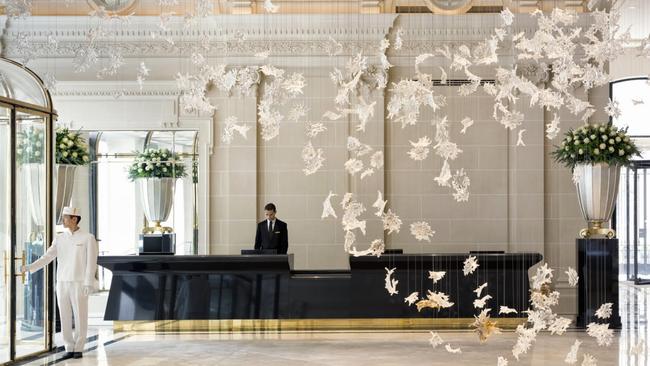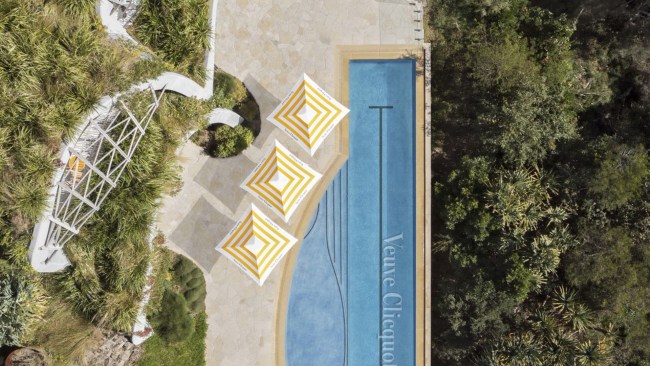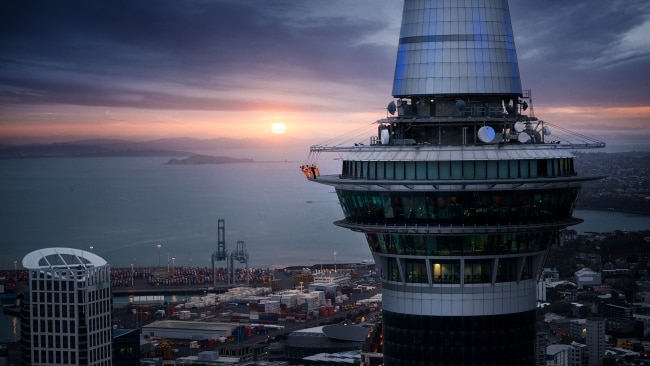East greets west at the Peninsula Paris
A NEW Asian-influenced hotel in Paris redefines global style.

THE Paris experience starts in the heart of Asia. The Peninsula Hong Kong, overlooking the Kowloon waterfront with unmistakable imperial hauteur, has geared up for the opening of its Parisian sibling. There is moody chanson playing in its fleet of dark green Rollers, its zippy Mini Clubmans have been painted with Parisian landmarks in distinctive red-white-and-blue tricolore.
The impeccable Cantonese restaurant, Spring Moon, has popped a steamed French turbot on the menu, served with black beans and olives; there’s a slick of black truffle sauce on the dumplings; duck terrine flavoured with dried plums and Chinese wine; and double-boiled Bresse chicken with ginseng.
In that legendary see-and-be-seen lobby there’s a Montmartre-themed afternoon tea, complete with tiny baguette sandwiches and live accordion music of French favourites. Flutes of Moet & Chandon are being served with spa treatments to add sparkle to proceedings.
The Paris property is the 10th for the Peninsula Hotels group but its first launch in Europe and guests are being primed to expect the subtle cross-cultural references that define this five-star portfolio.
On August 1, the doors — two grand entrances, on Avenues Kleber and Portugais — opened in a flurry of ribbon-cutting and Chinese lion dancing, a celebratory champagne cork’s pop from the Arc de Triomphe and Avenue des Champs-Elysees.
The French capital has seen a blossoming of new and revitalised luxury hotels in heritage buildings over the past five years, many managed by companies with Asian roots and heritage. There’s the newish Le Royal Monceau Raffles, Mandarin Oriental and Shangri-La vying for top-drawer business. Dorchester Collection’s substantially revamped Plaza-Athenee opened the same weekend as The Peninsula. Ritz Paris and Hotel de Crillon will be relaunched next year after thorough refurbishments. Makeovers are generally more funky than fusty; younger guests are increasingly catered for with cutting-edge technology and avant-garde design; the moneyed Chinese and Middle Eastern markets are conspicuously courted.
The 200-room, seven-storey Peninsula Paris’s location, in the stylish 16th arrondissement, is superb. From the rooftop L’Oiseau Blanc restaurant and terrace bar there are close-up views of the Eiffel Tower which, in a departure from customary Parisian elegance, flashes in jazzy gold on the hour from 8pm. Twist your head to the left and squint and there, as if sketched on the horizon by Toulouse Lautrec, are the domes of Sacre Coeur.
The legacy of the 86-year-old Peninsula Hong Kong, arguably one of the world’s greatest hotels, casts a large shadow. However, this is France — the clientele and expectations are different but the Peninsula essence must be maintained.
Eight French “ambassadors” were sent pre-opening to a boot camp in Hong Kong for a month to be immersed in all things Peninsula. The team included senior representatives from the Paris property’s front office, concierge desk, food and beverage, housekeeping, banqueting, catering, conferences and LiLi Cantonese restaurant.
It seems a little odd to be teaching the French how to run hotels but in the global village of the accommodation world little can be left to chance. Take LiLi, for example. It’s a dramatically designed space conceived by Henry Leung of Hong Kong-based designers Chhada Siembieda & Associates, all art nouveau flourishes, coloured chandeliers, midnight-blue walls, birdcage-like seats, cascading silk tassels by the renowned firm of Passementiers Declercq, and swooping red curtains.
All seems set for a performance of Chinese opera but the ceremony of serving Cantonese food may be unfamiliar to local staff and clientele. Restaurant manager Christophe Wong hovers as his waiters strain jasmine tea into lidded cups and politely inquires if guests would prefer to eat with les baguettes chinoises or knives and forks.
“Les chopsticks,” replies the gentleman diner in mulberry velvet jacket, silk cravat and colour-co-ordinated tasselled moccasins. He matches the decor so perfectly he may well recede from view.
Mais oui, the fashion. You will feel more at home here if you dress at least as expensively as the staff, your jewellery a match for the gold leaf that gleams in abundance, from friezes and columns to ceiling rosettes and sconces, about 40,000 pieces applied all up, each measuring 8 sq cm. Finely attired guests waft through voluminous spaces, across marble floors, passing platoons of white-capped pageboys and girls, down high-ceilinged corridors, beside Xavier Cordebo’s totemic Moon River sculpture, and through a shiny foyer in which a centrepiece from the Czech Republic of 800 hand-blown crystal leaves, each weighing 1kg, floats like an autumn windfall, echoing the foliage of the plane trees beyond.
Up at L’Oiseau Blanc, expect to be most surprised. A 75 per cent scale replica of a Lavasseur PL8 biplane, with an 11m wing span, is suspended over the adjacent courtyard, its nose tilted towards the Eiffel Tower. The real L’Oiseau Blanc aircraft, piloted by “two flying aces”, attempted a trans-Atlantic crossing from Le Bourget to New York in May, 1927, 12 days before Charles Lindbergh’s record-setting solo flight. The plane disappeared without trace but the exploits of the daring duo are celebrated in this unlikely setting, amid memorabilia aplenty, including a 1927 Lavasseur engine reassembled by volunteers, little planes and bluish clouds on tableware designed by Catherine Bergen of Maison Bernardaud in Limoges and, on chef Sidney Redel’s “bistronomy” menu, the ever-so-fancy L’Envol, a fruit-filled chocolate dessert shaped like a toy engine with a shortbread propeller on top.
Something less showy? The broad, yew-hedge Terrasse Kleber, covered by an industrial-looking steel-and-glass canopy, is the place for breakfast, teas, or a menu of burgers and light meals, and is set to be one of the 16th’s great meeting places. Effortlessly urbane general manager Nicolas Beliard says he is “testing” suitable heating for the upcoming winter; already this rapidly cooling summer, waiters are bringing blankets on demand to wrap chilled shoulders. He says a coffee on the terrace for the equivalent of about $7 is “inexpensive” compared with his five-star neighbourhood rivals.
Meals from LiLi can also be ordered here, perhaps shrimp dumplings with chives from the steamers of “dim sum ambassador” Chef Yip. Or nibble on rose-scented goat’s fromage made exclusively for the Peninsula Paris by Les Freres Marchands, one of France’s oldest specialist cheesemakers.
A pair of 1.7m-tall stone Chinese “door lions” guard the terrace’s entry steps, protecting the “home”, and looking rather discouraging, like a pair of bouncers. Conversely, though, this Avenue Kleber entrance is a less intimidating way to enter the hotel, taking you through (the confusingly named) Lobby dining room and into corridors and public spaces before entering the arrivals foyer on Avenue des Portugais, with reception, guest relations and a smart and snappy concierge desk overseen by Olivier Rouy, one of the Hong Kong-trained ambassadors.
And so to bed. The five top-floor suites — up there in, and on, the mansard roofs, their fish-scale slate tiles fashioned by hand — feature planted courtyards and sumptuous detailing such as handwoven silks and jacquards. They were not open during my visit last week but these promise to be the most agreeable of habitats with a pigeon’s-eye panorama of Paris’s textured skyline.
Other suites and guestrooms feature a well-considered array of contemporary artwork and mixed media hangings, recurring plane leaf patterns, deep Tai Ping carpets, leather headboards and a subdued palette from Henry Leung that’s best described as a grey-packaged box of chocolates, with ingredients from dark to milk to cream.
All the expected finery is present and correct, such as 100 per cent cotton Manchester, downy gowns, the latest Nespresso machines, and electronic curtains and blinds. There are flowering window boxes; silver bowls here (and throughout the hotel) are filled with white, yellow and palest pink roses.
A spacious dressing room is equipped with the Peninsula’s signature valet box so guests are left undisturbed when, say, messages or buffed shoes or laundry are delivered; huge marbled bathrooms have a telly inset beside the tub, multiple shower functions, Oscar de la Renta toiletries and a Japanese loo with warmed seat and whoosh-whoosh control panel. (Paris is not known as the world’s capital of inventive plumbing and I can well imagine our velvet-jacketed chap from LiLi exclaiming, “Mon dieu!”)
The beaux-arts building in “pied de Paris” limestone, with classic 19th-century Haussmann features and neo-classical exterior details, opened as the Majestic Hotel in 1908 on the site of the demolished Palais de Castille, once the pompous residence of the exiled Queen Isabella II of Spain. In 1919, the hotel accommodated the British delegation to the Paris Peace Conference; in May, 1922, Igor Stravinsky, James Joyce, Sergei Diaghilev, Pablo Picasso and Marcel Proust gathered for a dinner party in a private salon hosted by an English society couple in honour of the premiere of Stravinsky’s ballet Le Renard, performed by Diaghilev’s Ballets Russe.
In 1928, George Gershwin worked on An American in Paris while staying at the Majestic Hotel during a grand tour of Europe. After the occupation of Paris in World War II, the hotel was converted to UNESCO headquarters and later appropriated by the French Ministry of Foreign Affairs until 2009.
Joint venture partner Qatar-based Katara Hospitality, with its stated aim to “become one of the leading hospitality organisations in the world”, obviously has bottomless pockets. The Majestic Hotel was completed in two years but the Peninsula restoration took twice that period, included excavating several basement levels for parking and spa facilities, and involved 3000 highly skilled workers such as ornamental gilders, timber restoration experts, stonemasons from a company specialising in historic monuments, and master craftsmen whose forebears have worked on the restoration of French palaces and museums.
Architect Richard Martinet, who refers to himself as “a saver of beauties”, has spent six years on the project and retained as much of the original building’s fabric as possible.
“We used every part of the decor as a signature and to identify certain styles,” he says. “Through this vast project, the vestiges of spaces and decor of the former Majestic Hotel, lost in the numerous brutal transformations since 1980, again appear in their original state.”
Sepia photographs of the early 20th century show the identifiable contours of today’s Peninsula, complete with those avenues of plane trees skirting its corner site; guests sat on balloon-backed chairs at immaculate damask-clad tables on the summer terrace, and slept in curtained beds in chambers with panelled walls.
In 1973, the US and Vietnam signed the Paris Peace Accord in a ballroom that is now Le Bar Kleber, a snug space with Christofle crystal tumblers and the original Majestic Hotel oak panelling — removed, numbered, sanded, repaired, returned and waxed to perfection by Atelier Fancelli, a family outfit of 12 employees and typical of the bespoke companies involved in the project.
Two styles of afternoon tea — pale blends brewed with citrus peel and treats such as fig rolls, tiny carrot cakes with swirled orange cream topknots, and apricot and green tea macarons — conceived by chef patissier Julien Alvarez and executive chef Jean-Edern Hurstel (both of whom could easily flee the stoves and get work as models), are served on tiered silver stands in the ornamented Lobby, which could have been airlifted from Versailles.
If a Marie Antoinette lookalike in powdered wig and ballooning gown were to glide past and nod to the jazz trio, I would be scarcely surprised.
My favourite design integration, and the one I keep revisiting, is the hanging at the entry to LiLi. It’s a wall-sized installation of a portrait of a sultry Chinese maiden, powdered and painted like an opera performer or a courtesan, printed on a fabric of nylon webbing and net, and woven through with fibre optics so it shimmers and glows and flows, almost as if she is on the verge of a come-hither smile or a knowing wink.
It’s witty and fun, a stylised blend of oriental motif, tremendously clever technology and Parisian joie de vivre. There are the faintest scents of soy and ginger curling around the corner from Chef Tang Chi-Keung’s kitchen and buttery aromas from Alvarez’s 24-hour bakery. The restaurant hostess with the musical French accent looks relaxed and elegant in her cheongsam. Green tea or rose Champagne?
This moment seems to sum up everything that is so very chic and clever about The Peninsula Paris. Bienvenue.
CHECKLIST
All guestrooms are equipped with interactive digital tablets by the bed and on the writing desk; WiFi, in-room videos, minibar soft drinks and local and international phone calls are included in the tariff. There’s a spa, 22m indoor pool and fitness facilities; transfers and sightseeing available in two vintage Rollers, BMW 7 series saloons or Mini Clubmans. The three-course Oscar Bravo table-d’hote menu at L’Oiseau Blanc is E55 ($77). Rooms from E795 a night. More: peninsula.com/paris.
Cathay Pacific offers more than 70 flights a week from six ports in Australia to Hong Kong and on to more than 170 destinations; there are daily flights to Paris from Hong Kong (twice daily during the peak European summer) with streamlined connections to and from Australia. The airline claims the longest flat-beds of any business class. To float into a Parisian mood, the Foster+Partners-designed Wing first-class lounge at Hong Kong airport has a free-flow French Champagne bar. More: cathaypacific.com.au.
Susan Kurosawa was a guest of Peninsula Hotels and Cathay Pacific Airways.



